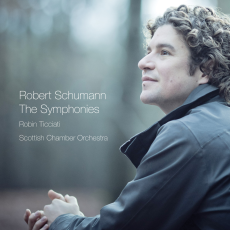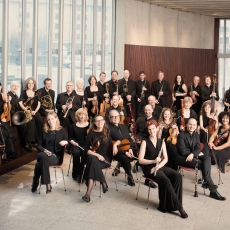Robin Ticciati & SCO - Schumann: The Symphonies - Fanfare
In a fascinating article by Peter Gutmann, titled Robert Schumann Symphony #4 in D Minor (& the Issue of Orchestration) - classicalnotes.net/classics3/schumannsym.html - the author poses an interesting theory on why Schumann's orchestration has been so widely maligned. Schumann, Gutmann suggests, was a victim of his time and circumstance, caught in a vise, as it were, between changing notions of what orchestration meant.
Prior to Schumann, an orchestra's instrumentation was relatively standard and stable. Throughout the Classical period, up to and including Beethoven, orchestration was not thought of as a primary musical element in the same category as melody, harmony, and rhythm; it had not yet achieved the status of an art unto itself. Composers, for the most part, composed at the keyboard, and then orchestrated their works pretty much based on standard practices and the physical capabilities and limitations of the instruments at their disposal.
The composer who changed that model was probably Berlioz. He chose instruments for their specific dramatic, picturesque, and coloristic capabilities, and he not only scored for instruments that had not previously been admitted to the orchestra, he required conventional instruments to do unconventional things - such as directing the violins to play col legno and sul ponticello in his Symphonie fantastique.
By the time we come to Schumann, orchestration as "art" had become the new normal; it was now music's fourth primary element, after melody, harmony, and rhythm. Yet Schumann clung to the conservative methods of his Classical period predecessors. Thus, comments such as those by Adam Carse, who wrote in 1925, "Schumann was unable to handle the orchestra even moderately well; his music survives in spite of its orchestration," and conductor Theodore Thomas, founder of the Chicago Symphony, who wrote in a 1922 New York Times article, "Such fine, noble themes, good workmanship, and yet such abominably bad orchestration," need to be taken in the context of judgments made against Schumann's orchestration, not because it was actually bad, but because it was backward-looking for its time and didn't meet the expectations of those who had become accustomed to the "orchestration as art" paradigm.
And that, as we know, led to mischief. Interventions by a number of conductors purported to fix the problems of Schumann's orchestration with additions, subtractions, and alterations, some more radical than others. Gutmann's above-referenced article quotes the program note to a 1921 Chicago Symphony concert of Schumann's Symphony No. 3: Conductor Frederic Stock "found it necessary to add a measure here and there, added contrapuntal embellishment, rewrote the finale (but employed the master's material), and added a dozen instruments for a variety of color effects, including a piccolo, English horn, bass tuba, bass drum, cymbals, triangle (!), and a tambourine (!!)."
Maestro of the Cleveland Orchestra, George Szell, was wont to grant Schumann the benefit of the doubt, but that didn't deter him from remedying what he considered "balance" problems by thinning out textures, eliminating doublings, adding or changing notes to clarify themes, rewriting the timpani parts to reinforce the harmony, and generally adjusting dynamics. He stated his goal as "to make the symphonies sound as if Schumann had as much knowledge of orchestration as Weber, but not as much as Richard Strauss." Szell's "improvements" are on display in his 1960 Cleveland recordings of Schumann's symphonies on Sony.
Mahler was no purist either. He made 466 changes to the score of Schumann's Fourth Symphony, though most involve dynamics and are not as readily evident to the ear as are the more draconian changes made by others. Riccardo Chailly relied on Mahler's retouches for his 2006 Leipzig Gewandhaus "Mahler Edition" Schumann cycle on Decca.
Leonard Bernstein is often given credit for being the first to record Schumann's symphonies in their original scoring in his 1960 cycle with the New York Philharmonic, but according to Gutmann, Paul Paray beat Bernstein to the punch in his 1950s Schumann cycle with the Detroit Symphony Orchestra, and without the fanfare of hyping it on the album cover.
In the liner note to the present Ticciati cycle, there is only one oblique reference to the this whole issue, and all it says is, "Commentators have complained that the complexity of Schumann's part-writing was due to the fact that he was, in effect, writing piano music for orchestra. But the subtleties of the part-writing are an element of Schumann's characteristic orchestral sound, as the leaner performances of the last 30 years have allowed us to hear."
Granted, it's not exactly a bankable statement, but it does seem to suggest that the performances we have here are true to Schumann's original scores. The young, London-born conductor Robin Ticciati has been rapidly amassing a discography of repertoire as mixed as the reviews he has been receiving in Fanfare , including two or three by me. He has jumped from operas by Mozart, Humperdinck, and Tchaikovsky to orchestral and choral works by Berlioz, Bruckner, and Brahms.
I'm given to understand that another Fanfare contributor also received this Ticciati Schumann set for review, though I don't know who it is or what he or she may have said about it, so I will be curious to read the corresponding review. My reaction to Ticciati's Schumann and to these Linn recordings is decidedly positive. Articulation is crisp, tempos well chosen and maintained, orchestral balances well managed, and orchestral execution clean, precise, and responsive. A problem with Linn recordings I've complained of in the past-namely, a too-low recording level and sound that becomes congested and muddy when you raise the volume level to compensate-is not in evidence here. The recordings have an open, airy ambiance, and the dynamic spread is wide.
Recent auditioning of Schumann symphonies by Thomas Dausgaard with the Swedish Chamber Orchestra and by Christian Zacharias with the Lausanne Chamber Orchestra have left me feeling like something was missing. The playing was faultless and the readings carefully considered, but there was a flatness or dullness to the performances which I ultimately attributed to a lack of real passion and enthusiasm for the music. I don't sense that at all from these performances by Ticciati and the Scottish Chamber Orchestra. There's a real sense of engagement here, and for the first time in recent memory, I've actually found myself responding to Schumann's symphonies with more than just a shrug of the shoulders and a "well, that was nice" feeling. The scherzo to the C-Major Symphony (No. 2), for example, ought to make my head sway from side to side and bob up and down, and in this performance, it does.
As I said, I'll be curious to read what my mystery colleague has to say about this set, but for me, this is one of the best Schumann symphony cycles to come my way in a very long time, maybe even ever.


